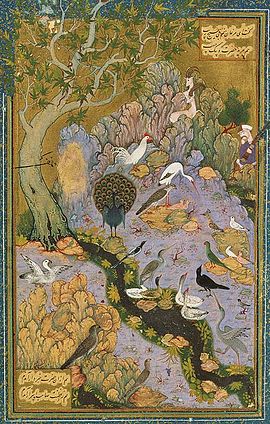- The Conference of the Birds
-
"Conference of the Birds" redirects here. For other uses, see Conference of the Birds (disambiguation).
 "The Concourse of the Birds" painted by Habib Allah. The hoopoe, center right, instructs the other birds on the Sufi path.
"The Concourse of the Birds" painted by Habib Allah. The hoopoe, center right, instructs the other birds on the Sufi path.
The Conference of the Birds (Persian: منطق الطیر, Mantiqu 't-Tayr, 1177) is a book of poems in Persian by Farid ud-Din Attar of approximately 4500 lines. The poem's plot is as follows: the birds of the world gather to decide who is to be their king, as they have none. The hoopoe, the wisest of them all, suggests that they should find the legendary Simorgh, a mythical persian bird roughly equivalent to the western phoenix. It is an allegory of the quest for God (The Simorgh). The hoopoe respresents a sufi master and each of the other birds represents a human fault which prevents man from attaining enlightenment. When the group of thirty birds finally reach the dwelling place of the Simorgh, all they find is a lake in which they see their own reflection.
Besides being one of the most celebrated examples of Persian poetry, this book relies on a clever word play between the words Simorgh – a mysterious bird in Iranian mythology which is a symbol often found in sufi literature, and similar to the phoenix bird – and "si morgh" – meaning "thirty birds" in Persian.
- It was in China, late one moonless night,
- The Simorgh first appeared to mortal sight –
- He let a feather float down through the air,
- And rumours of its fame spread everywhere; [1]
Its most famous section is:
- Come you lost Atoms to your Centre draw,
- And be the Eternal Mirror that you saw:
- Rays that have wander'd into Darkness wide
- Return and back into your Sun subside
In the 1970s the poem was adapted into a play, called The Conference of The Birds, by Peter Brook and Jean-Claude Carrière. Brook toured the play around rural Africa before presenting two extremely successful productions to western audiences, one in New York City at La MaMa, E.T.C. and one in Paris.[2]
The story recounts the longing of a group of birds who desire to know the great Simorgh, and who, under the guidance of a leader bird, start their journey toward the land of Simorgh. One by one, they drop out of the journey, each offering an excuse and unable to endure the journey. Each bird has a special significance, and a corresponding didactic fault. The guiding bird is the hoopoe, while the nightingale symbolizes the lover. The parrot is seeking the fountain of immortality, not God and the peacock symbolizes the "fallen soul" who is in alliance with Satan.
The birds must cross seven valleys in order to find the Simorgh: Talab (Yearning), Eshq (Love), Marifat (Gnosis), Istighnah (Detachment), Tawheed (Unity of God), Hayrat (Bewilderment) and, finally, Fuqur and Fana (Selflessness and Oblivion in God). These represent the stations that a Sufi or any individual must pass through to realize the true nature of God.
Within the larger context of the story of the journey of the birds, Attar masterfully tells the reader many didactic short, sweet stories in captivating poetic style. Eventually only thirty birds remain as they finally arrive in the land of Simorgh – all they see there are each other and the reflection of the thirty birds in a lake – not the mythical Simorgh. It is the Sufi doctrine that God is not external or separate from the universe, rather is the totality of existence. The thirty birds seeking the Simorgh realise that Simorgh is nothing more than their transcendent totality. The idea of God within is an idea intrinsic to most interpretations of Sufism. As the birds realize the truth, they now reach the station of Baqa (Subsistence) which sits atop the Mountain Qaf.
See also
- Language of the birds
- Parlement of Foules
- Persian literature
- Seven Valleys (Bahá'í)
- Sheema Kalbasi (editor & translator of Seven Valleys of Love, a bilingual anthology of poetesses from Persian Middle Ages to present day)[3]
- The Approach to Al-Mu'tasim
References
- ^ quoted from The Conference of the Birds by Farid al-Din Attar, edited and translated by Afkham Darbandi and Dick Davis, Penguin Classics, 1984, ISBN 978-0140444346
- ^ The story is told in Conference of the Birds (book), the play was also translated from French to Hebrew by Ouriel Zohar
- ^ PRA Publishing, 2008. ISBN 978-09727703-8-5
- Attar, Harvey & Masani, Conference of the Birds: A Seeker's Journey to God, Weiser Books, 2001, ISBN 1-57863-246-3
- Farid Ud-Din-Attar, The Conference of The Birds - Mantiq Ut-Tair, English Translation by Charles Stanley Nott, First published 1954 by The Janus Press, London, Reissued by Routledge and Kegan Paul Ltd, 1961, ISBN 0-7100-1032-X
External links
- Selection of Attar and related poets' poetry
- Simurgh: A modern musical rendering of Attar's allegorical tale
- The Conference of the Birds, available from the Packard Humanities Institute
- abridged Edward FitzGerald translation of Attar's Conference of the Birds
- Conference of the Birds an opera by Johan Othman and libretto by William Radice
Categories:- Persian literature
- Sufi literature
- Attar of Nishapur
Wikimedia Foundation. 2010.
